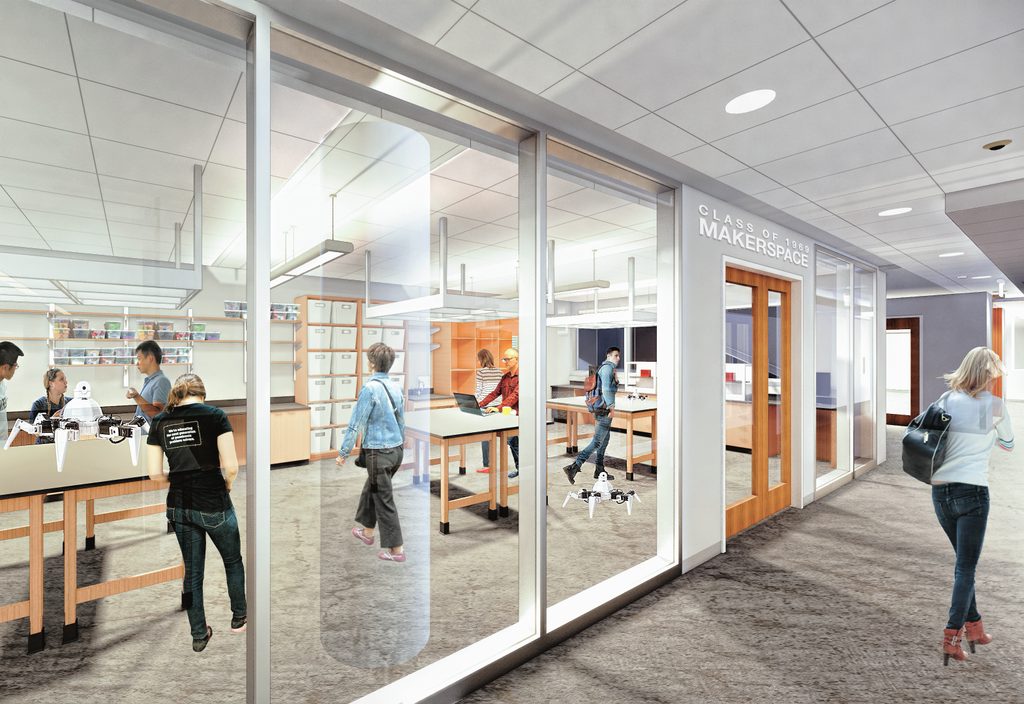An interdisciplinary makerspace in Carleton’s new Anderson Hall will equip hands-on learners with new technology and opportunities to collaborate.

Hands-on creation isn’t new to Carleton. Studio art classes include metalsmithing and printmaking, theater students construct scenery and design costumes, and physics projects utilize electronics and the college’s instrument shop. Yet something has been missing — something cohesive, binding all disciplines together.
More and more, Carleton students and faculty members want to demonstrate learning with multimedia, cross-disciplinary approaches such as video, sculpture, or 3D displays. With this in mind, the college identified a need for a space that would foster creativity that overcomes preconceptions of interests and abilities. Rather than silos of tactical learning, Carleton students will now have a central makerspace for designing and prototyping project ideas for classes—or for fun.
Funded by the Class of 1969, the makerspace will feature high-tech tools such as 3D printers, laser cutters, and drilling machines, as well as ordinary, useful supplies such as Legos, foam, fabric, and glue guns. It will also house computers, microprocessors, electronic components, and soldering irons.
“The makerspace in the integrated science center will provide a new hub for making that isn’t tied to any one department,” says physics professor Melissa Eblen-Zayas. “This will be a place where students with a variety of interests and levels of experience can gather to design, prototype, and build projects for curricular purposes, for cocurricular activities, and for fun. The makerspace, however, is more than just a physical space—it’s about creating a community of users who share expertise and support each other in gaining new skills and transforming creative ideas into hands- on projects. We hope the new makerspace will contribute to a broad culture of making on campus.”
A Walk in Virtual Reality

A bell rings, the elevator doors close, and a slight jolt and faint mechanical hum signal the beginning of a remarkable ride.
Ken Abrams, associate professor of psychology at Carleton, is standing by your side, close enough to whisper. When the elevator doors open again, he gently encourages you to step outside. But there’s no floor on this 50th floor. All you can see is blue sky. All you can hear is chirping birds above and a busy city street below. And the only way forward is on a narrow wooden board jutting out over the expanse.
Then, after blowing in the wind for two beats too long, you’re given a choice: Come back to the elevator or jump.
The ground rushes up and everything goes white. No, Professor Abrams is not visiting your nightmares. He’s conducting a demonstration of virtual reality technology in a lab space on the first floor of Olin Hall. “There is some evidence that suggests you can effectively address phobias in a lab setting, as opposed to having to take your client to the top of a tall building or take them on an airplane,” he says. “It’s a forward- looking approach.”
Since receiving a few thousand dollars in funding last fall to purchase the headset, VR hardware, and attendant software (just a decade ago it would’ve cost in excess of $35,000), Abrams has been plumbing the emerging technology’s academic potential. The 30 students in his winter psychopathology course took the board walk to get a sense for the avant-garde therapies described in their textbooks. In winter and spring terms, his eight lab students in a Virtual Reality and Anxiety course explored a series of hypotheses that involve exposing subjects to distressing scenes and then determining whether other sorts of stimuli can replace the experience before it becomes a traumatic memory.
“Past research has suggested that tasks such as playing video games with clear visuospatial components, such as Tetris, could work,” Abrams says. “Otherwise, completing puzzles, mentally rotating objects, copying designs, and the like could in theory be effective. We are examining the ideal length of these interference tasks for reducing intrusive memories.”
